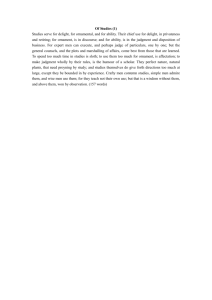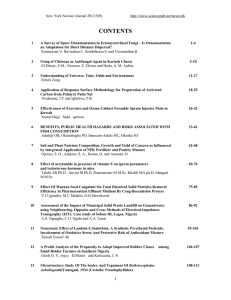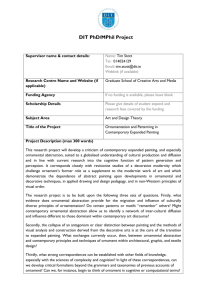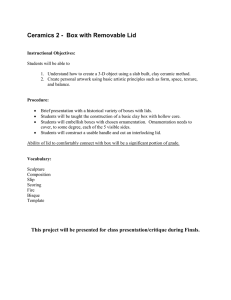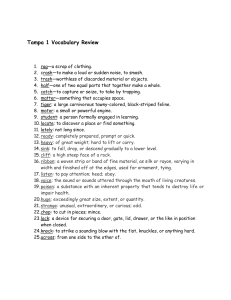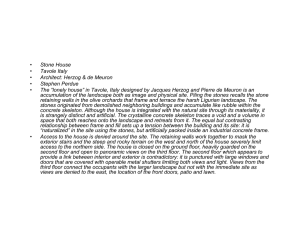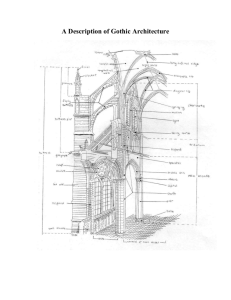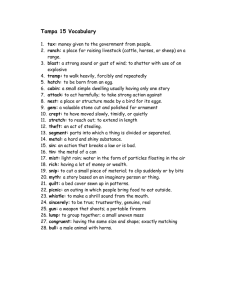Manufacturing Surface Effects
advertisement
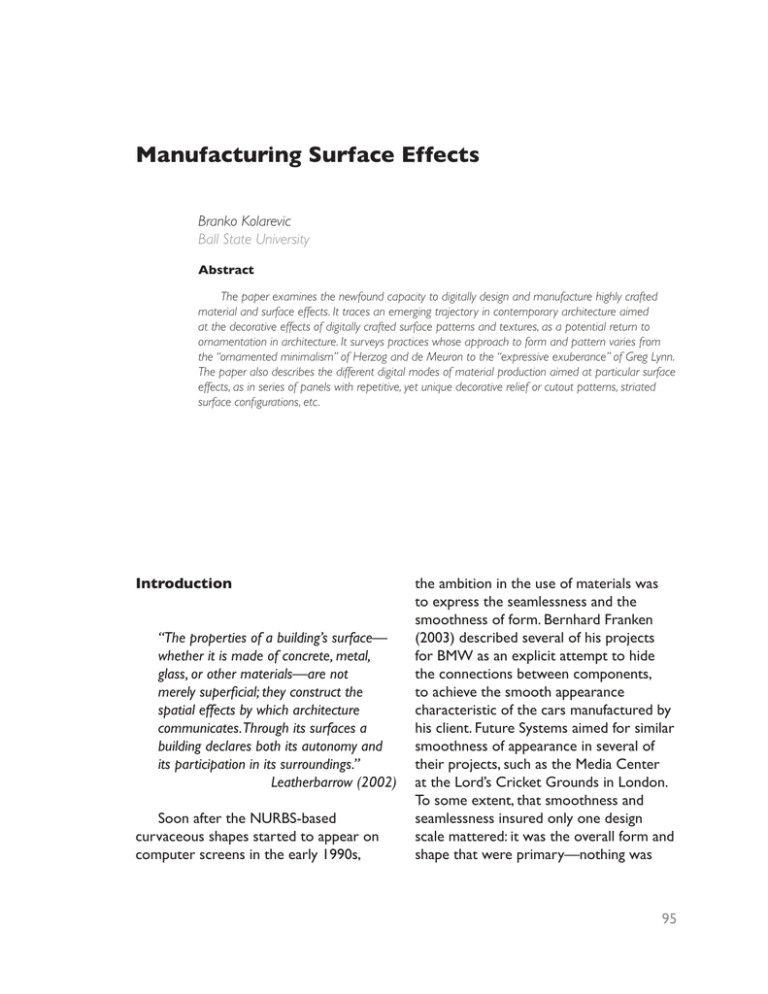
Manufacturing Surface Effects Branko Kolarevic Ball State University Abstract The paper examines the newfound capacity to digitally design and manufacture highly crafted material and surface effects. It traces an emerging trajectory in contemporary architecture aimed at the decorative effects of digitally crafted surface patterns and textures, as a potential return to ornamentation in architecture. It surveys practices whose approach to form and pattern varies from the “ornamented minimalism” of Herzog and de Meuron to the “expressive exuberance” of Greg Lynn. The paper also describes the different digital modes of material production aimed at particular surface effects, as in series of panels with repetitive, yet unique decorative relief or cutout patterns, striated surface configurations, etc. Introduction “The properties of a building’s surface— whether it is made of concrete, metal, glass, or other materials—are not merely superficial; they construct the spatial effects by which architecture communicates.Through its surfaces a building declares both its autonomy and its participation in its surroundings.” Leatherbarrow (2002) Soon after the NURBS-based curvaceous shapes started to appear on computer screens in the early 1990s, the ambition in the use of materials was to express the seamlessness and the smoothness of form. Bernhard Franken (2003) described several of his projects for BMW as an explicit attempt to hide the connections between components, to achieve the smooth appearance characteristic of the cars manufactured by his client. Future Systems aimed for similar smoothness of appearance in several of their projects, such as the Media Center at the Lord’s Cricket Grounds in London. To some extent, that smoothness and seamlessness insured only one design scale mattered: it was the overall form and shape that were primary—nothing was 95 allowed to distract from the expressive and atypical geometry of the exterior skin. The infatuation with complex geometry in mid-1990s soon branched into the computational exploration of highly crafted surface effects that led to a reemergence of pattern and ornament (by association), which had been banished from architecture for a large part of the twentieth century. This shift toward the ornamental or decorative stemmed partly from pragmatic requirements which building skins have to satisfy, partly from purely aesthetic considerations, and partly because of the old-fashioned need for scale and tactility in buildings. The emergence of the new digitally-based techniques of design and production opened up new ways to introduce pattern, texture and relief onto architectural surfaces (Kolarevic 2003, 2004). Greg Lynn, for example, developed various strategies of creating apertures in the curvy skins of his building through “shredding”; the smooth morphology was adapted to the pragmatic requirements of bringing light and air into the buildings. The resulting striated, shredded surfaces attain a changing but smooth rhythm, a pattern of alternating voids and solids that can both dematerialize parts of the skin or render the skin as a whole almost entirely opaque depending on the viewing direction; the “shredding” also adds a much needed sense of scale. In addition, the “shredding” can provide for a subtle, dynamic optical effect resulting from the changing angle of the viewer’s eyes to the surface, which was aptly demonstrated by the “shredded” skin of twisted copper strips in the Signal Box by Herzog & de Meuron. Among contemporary design practices, Herzog & de Meuron stand out in their 96 unapologetic exploration of pattern, texture and relief and the resulting material and surface effects they can produce. The “ornamented minimalism”—a seemingly minimalist geometry of the building, often wrapped with a highly decorative skinhas become their signature. In the Eberswalde Library, a conventional box building with horizontal, alternating strips of concrete and glass, images were silk-screened onto glass and concrete panels, literally blurring the material distinctions between the two. The new addition to the Walker Art Museum in Minneapolis, similarly, features a skin made from crumpled, aluminum mesh panels, “a blur between solid, translucent, and transparent” in the words of Jacques Herzog. Ornamentation is not limited to the building skin only, however; the interior surfaces of the museum addition are likewise decorated by swirling, lacy patterns cut in wood or embossed in metal panels. The scale of decoration in the buildings by Herzog & de Meuron can vary vastly, from several feet to several hundred feet. The large surfaces of the rain screen at the De Young Museum in San Francisco are made from over 7,000 copper panels (12 feet by 2 ½ feet in size), each of which features unique halftone cutout and embossing patterns abstracted from images of the surrounding tree canopies (figure 1). The circular perforations and indentations produce abstract images when seen from a distance, similar to how halftone patterns of dots of varying size fool the eye into seeing different shades of gray in newspapers. The rain screen cladding is obviously decorative, but it also has a purely functional purpose—to hide an integrated ventilation system and ACADIA 2006: Synthetic Landscapes Digital Exchange Digital Making: Superficies: Integral and Applied Figure 1. The perforation and indentation patterning of the rain screen panels in De Young Museum by Herzog & de Meuron. to diffuse exterior light falling into the galleries. Such a functional approach to ornamentation is typical of many of the projects by Herzog & de Meuron. Patterned surfaces of the Federation Square building in Melbourne (figure 2), designed by Lab Architecture Studio, and are based on what is known in mathematics as pinwheel aperiodic tiling, enabling the designers to apply different scales of the same pattern across the building as needed. There are other notable examples in which patterning is based on mathematics. Daniel Libeskind, for example, proposed a patterned skin based on fractals for the extension he designed for the Victoria & Albert Museum in London. In these, as in many other recently completed projects, the patterning is almost purely decorative, i.e. there is little if any of the “functionalist ornamentation” as seen in the work of Herzog & de Meuron. A good example of this purely decorative application of ornamentation is the recently completed Ministry of Culture Branko Kolarevic Manufacturing Surface Effects Figure 2. The pinwheel aperiodic tiling of the Federation Square buildings in Melbourne by Lab Architecture Studio. and Communication in Paris, designed by Francis Soler, which is wrapped in what C.C. Sullivan (2005) referred to as “technouveau” latticework, a screen of stainless steel with six recurring, symmetrical motifs (figure 3). Figure 3. Ministry of Culture and Communication in Paris by Francis Soler. 97 Working on a different scale of a single panel, Bernard Cache also has explored the decorative realm of pattern, texture and relief, which seems to be the current preoccupation of Greg Lynn (2004) too, who, for example, in some of his recent projects uses “surface geometry to emit texture information so that, like an animal skin, the pattern and relief is intricate with the form.” Cache created parametric CAD/CAM production processes in which slight variations of parameter values, either incremental and/or random, would produce a series of differentiated yet repetitive objects, called objectiles, each of which would feature unique decorative relief or cutout patterns, striated surface configurations, etc. A particularly effective technique was to exploit inherent properties of the material, such as varying coloration of different layers in laminated wood sheets, to produce intricate surface effects by CNC-milling relatively small 3D curvilinear forms (figure 4), thus introducing a certain “economy of production” by reducing the amount of machining and material waste. Another, fairly recent trajectory in contemporary architecture is to seek out the unity of skin, structure, and ornament (as a contemporary expression of Vitruvius’ firmitas, utilitas and venustas) through a digitally driven manufacturing process that provides for variability in volume, shape, texture and appearance To that end, composite, layered materials, Figure 4. Objectiles, designed by Bernard Cache. 98 commonly used in automotive, aerospace, shipbuilding and other industries, are experimented with for possible architectural applications, as they offer the unprecedented capability to design material effects by digitally controlling the production of the material itself. The composition of such materials can be engineered precisely to meet specific performance criteria, so that properties can vary across the section to achieve, for example, a different structural capacity in relationship to local stress conditions, or to vary fiber density to achieve different opacity and appearance. By manipulating material variables in composites for local performance criteria, entirely new material, tectonic and ornamental possibilities open up in architecture. Digital Fabrication and Surface Effects The different techniques of manufacturing surface effects using digital fabrication technologies were explored in a four week project within an elective course at the University of Pennsylvania offered in the spring of 2005 and in the fall at Ball State University. Students had to define a parametric production process in which slight variations of parameter values, either incremental or random, would produce a series of differentiated yet repetitive ornamented objects, featuring a combination of pattern, relief, and texture. The produced objects were then organized in a grid-like configuration to produce a carefully choreographed field effect. The objective was to investigate potential figurative expressiveness of (architectural) surfaces, i.e. their capacity to communicate visually. ACADIA 2006: Synthetic Landscapes Digital Exchange Digital Making: Superficies: Integral and Applied By working in groups of two, students developed a geometric and manufacturing logic for producing different instances of a parametrically defined variable paneling system, in which the size is fixed, but the relief or cutout patterns can vary. The emphasis was placed on the calculation of curved and variable shapes and their production using CNC tool paths precisely crafted in software and executed on a CNC milling machine. Carmen McKee and Fuyuan Su modeled a simple time-based parametric process in Maya animation software that resulted in different undulations of a rectilinear surface. Isoparametric curves, used in visualizing NURBS surfaces, were extracted from selected frames and were translated directly into CNC tool paths for milling (figure 5a). The density and number of isoparametric curves were carefully explored, as were the sizes of milling bits and whether the round or flat ones should be used. Equally important were the hardness and the texture of the wood to be used in production. Thus, the process was defined by parameters related to the designed geometry, parameters pertaining to production (such as the size of the milling bit, the feed rate, etc.) and parameters related to the material itself, such as wood hardness, grain size, etc. These parameters were interrelated and numerous instances were explored through several iterations informed by continuous feedback loops between design and production. In the end, the panels were manufactured at the rate of 15 minutes per panel (each of which was 1’ by 2’ in size) and assembled in a linear configuration (figure 5b). The parameters that defined the geometry of the panels designed by Branko Kolarevic Manufacturing Surface Effects Figure 5a. Carmen McKee and Fuyuan Su used Isoparametric curves directly as CNC tool paths. Figure 5b. CNC-milled wood panels by Carmen McKee and Fuyuan Su. Jill Desimini and Sarah Weidner were based on image processing techniques of halftoning and motion blur. Images selected from a video sequence were first halftoned in Photoshop and then a motion-blur filter was applied to the halftones, resulting in what looked like a grayscale image of an undulating surface (figure 6a). These images were then imported into Rhinoceros modeling software to define the extent of deformation of a flat, meshed square surface. The deformed surface configuration was then used to compute the milling paths in MasterCAM. As in the previous project, the parameters related to the production (size of the milling bit, etc.) and the properties of the material (texture, hardness, etc.) were crucial to the overall success of the project, as 99 Figure 6a. Image processing by Jill Desimini and Sarah Weidner. Figure 7a. “Parametric weave” by Virginia Little and Maggie McManus. Figure 6b. The field configuration of CNC-milled wood panels by Jill Desimini and Sarah Weidner. Figure 7b. Close-up of the “parametric weave.” were the feedback loops between design and production. After several, quick iterations over four weeks, the final field configuration of nine panels (figure 6b) were carefully and quickly produced. Virginia Little and Maggie McManus also modeled a simple time-based parametric process in Maya animation software that resulted in slight, ripplelike undulations of a rectilinear surface. Isoparametric curves were extracted in both U and V directions from each instance of the surface configuration, and were then used as sweeping paths for circular profiles of gradually increasing radii. The resulting configuration of “tubes” was cut with a flat plane, revealing the internal voids in the tubes, and producing an intricate surface effect (figure 7a). That “parametric weave” was then milled quickly in ordinary insulation foam panels, which were then coated with a layer of white hi-gloss latex house paint, resulting in an intricate latticework screen configuration (figure 7b). Dustin Headley and Mickel Darmawan were interested in carving out a complexly shaped volume from a stack of layered sheets, which were then spaced apart to reveal the inner void (figure 8). The outcome was quite surprising: if one’s eyes were to move along the side of the resulting construct, a subtle, dynamic effect emerged. The performative aspects of the “kinetic hyposurface,” as named by the students, were then fine-tuned by exploring the different values for the key parameters, such as the thickness of the layers and the size of the spacing between the layers. As was the case with previous 100 ACADIA 2006: Synthetic Landscapes Digital Exchange Digital Making: Superficies: Integral and Applied Figure 8. The “kinetic hyposurface” by Dustin Headley and Mickel Darmawan. projects, the parametric definition of the geometry was fairly simple, as was the production of the individual panels. After several quick iterations, the (virtually kinetic) result was more than a sum of the (static) panels, which were carefully arranged in a linear sequence. Given that these explorations were not conducted in a studio setting, but in an experimental seminar focused on the digital modes of production, a certain “economy of method” was introduced as a basic requirement for the project, as in “less effort, less machine time, less material, less waste,” which can be summed up as “less for more.” As illustrated by the projects described above, not all students adhered to these design and production demands. Nevertheless, they were an important dimension of the projects. Appearance and Substance “Ornament shapes, straightens, and stabilizes the bare arid field on which it is inscribed. Not only does it exist in and of itself, but it also shapes its own environment—to which it imparts form.” Focillon(1992) The projects and the ensuing discussions centered on the perennial questions of surface and form versus Branko Kolarevic Manufacturing Surface Effects structure, of appearance versus substance (or superficiality versus essence, as seen by some) in contemporary architecture. While the digital technologies of parametric design and fabrication opened new possibilities for non-uniform, nonmonotonous, variable patterning and texturing of surface, the question of appropriateness, i.e. of the cultural significance of such ornamental treatment of surfaces in a contemporary context also emerged. Following the famous manifesto Adolf Loos published in 1908, polemically titled “Ornament and Crime,” in which he described ornament as a need of the primitive man, arguing that the lack of decoration is a manifestation of a progressive, advanced culture, the emergence of the Modern movement entrenched a perception that to be authentically “modern,” one has to categorically remove all ornament, which consequently led to the barren surfaces of much of the twentieth century architecture. It was the absence of surface ornamentation that arguably made the minimalist aesthetics of Modernism less “affectionate,” contributing in part to its demise. The facades did not shed the rhythm and the pattern—but their monotonous grids did not give much to the eye. We took the “Semperian” position that “architecture comes to be defined in its essence as an ornamental activity” (Semper 1863). After all, throughout history (bar the second half of the twentieth century) ornamentation was used in buildings, both on the exterior and in the interior, to enhance and amplify presence and appearance, give scale and texture through intricate treatment of 101 surfaces, and demonstrate the mastery of artisans and craftsmen. Ornamentation had largely a symbolic function—it embodied values and ideals that defined a particular culture, simultaneously acting as a symbolic construct and enabling construction of symbolic meaning. Such an approach to ornamentation is in line with the view that the buildings are shaped by and are expressive of the social, economic, political, and cultural context, i.e. buildings are representational, while simultaneously being active agents in defining that very same context. Given the increasing presence of ornamentation in contemporary design (and not just in architecture but in a range of design disciplines), an obvious question to ask is if there is any deeper significance, some kind of profound relevance of ornamentation today. A possible answer to that question could start with a definition of what constitutes an ornament in a contemporary context. As there are many possible definitions, perhaps it would be more appropriate to begin by making some basic distinctions between different kinds of ornament in architecture. In general, ornamentation can be decorative or applied, functional or integral, and mimetic or imitative. Ornament, when purely decorative, relies on its application to an already existing surface or an object; hence, such ornamentation could be classified as applied. Structural ornament is considered an integral part of the building’s structure, i.e. the structural components act simultaneously as ornaments, as was the case, for example, in gothic architecture. Such ornamentation can be described as functional or integral. Mimetic or imitative ornamentation is characterized 102 by unambiguous meanings or symbolic significance—it is purely representational. Today, however, when “decorative” is used to describe an artifact, the meaning is negative in most cases, suggesting that the work itself is superficial, devoid on any deeper meaning. The perception of superficiality often stems from the surface application of ornamentation—it is often seen as nothing more than an (unnecessary) embellishment to an “other,” as was the case for most of the twentieth century. When decoration is deployed in a contemporary context, it is often used to hide something unpleasant to the eye—a functional application that is often judged as acceptable (Herzog & de Meuron used an ornamented rain screen to hide an integrated ventilation system on the façade of the De Young Museum). Decoration, however, is increasingly seen as performative as well, as it can produce effects that can directly affect an emotional response; it can be excessive or minimal, “loud” or “quiet,” “serious” or “cheerful.” It can accentuate a specific quality of the object or of the surface to which it is applied. Another way of understanding the significance of ornament is to compare it to pattern, which could be described as an abstract construct characterized by repetition. As such, patterns exist in nature in all sorts of imaginable shapes, forms, and sizes. It is only when a particular pattern is recognized and represented in some physical manifestation, such as decoration for example, that it becomes a cultural artifact—an ornament. The human need to perceive, organize, and structure the world around us into patterns and rhythms is seen as intrinsic; ACADIA 2006: Synthetic Landscapes Digital Exchange Digital Making: Superficies: Integral and Applied decoration and ornament are recognized as indicators of neurological synergy of the eye and the brain. E.H. Gombrich (1979) offers evolutionary arguments that ornament is a result of a biological need to generate underlying structure in the surrounding environments: “I believe that in the struggle for existence organisms developed a sense of order not because their environment was generally orderly but rather because perception requires a framework against which to plot deviations from regularity.” According to Gombrich, the human mind has an intrinsic need for “careful balance” between complexity and order. The mind has no trouble deconstructing a simple, regular grid (i.e. recognizing the monotonous); it quickly “disconnects” in reading complex configurations if it cannot recognize an underlying structure. Gombrich argues that a “careful balance” between these two conditions, i.e. between monotony and complexity, is what the mind looks for in its constant processing of the surrounding environments. In other words, one could argue that patterning—or ornamentation—is a necessity, and perhaps as such, it should be given back the significance it once had in architectural discourse. Note This paper is based on a version previously published in the Proceedings of the Game Set & Match II Conference held in March of 2006 at the Delft Technical University in the Netherlands. Branko Kolarevic Manufacturing Surface Effects References Focillon, H. (1992). The Life of Forms in Art. Trans. George Kubler. New York: Zone Books. Franken, B. (2003). Real as Data. In Architecture in the Digital Age: Design and Manufacturing, ed. B. Kolarevic. London: Spon Press. Gombrich, E.H. (1979). The Sense of Order: A Study in the Psychology of Decorative Art. Ithaca, NY: Cornell University Press. Kolarevic, B.,ed.. (2003). Architecture in the Digital Age: Design and Manufacturing. London: Spon Press. Kolarevic, B. (2004). Designing and Manufacturing Material in the Digital Age. In Evolving Tools: Digital Fabrication in Architectural Education, ed. Aron Temkin. Proceedings of the ACADIA 2004 Conference, Cambridge, Canada: University of Waterloo School of Architecture Press. Leatherbarrow, D. and M. Mostafavi. (2002). Surface Architecture. Cambridge: MIT Press. Loos, A. (1908). Ornament and Crime. In Ornament and Crime: Selected Essays. Trans. Michael Mitchell. (1997). Riverside, CA: Ariadne Press. Lynn, G. (2004). Online at www.glform. com. Semper, G. (1863). Style in the Technical and Tectonic Arts; or, Practical Aesthetics. 2004. Introduction by Harry Francis Mallgrave.. Los Angeles: Getty Research Institute. Sullivan, C.C. (2005). Screen Gem. Architecture. September 2005: 67. 103
